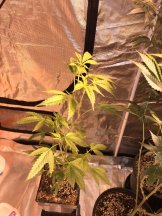I'm sure you have, but have you encountered a male with intersex issues?
I have, it was a Buckeye Purple F2BX1 male that was developing as a male for the first 3 weeks of flower, but began developing 50/50 sacs/pistils. He was a true intersex plant that kept the 50/50 development until culled.
With your experiences, if a male is carrying a dominate hermaphroditic trait, will it always present it's intersex issues during flower?
I did not use the intersex male to find out, but if I had to speculate: I would assume the intersex trait would carry through as any other trait would. You would see a solid percentage of the progeny expressing this as you would observe the smell, leaf shape, etc.
Again, this is just speculation, but without any reason to think intersex traits are somehow heritably different than any other, you'd be dealing with intersex plants in the seeds. Intersex plants are different from "
hermie-prone" plants in that they are not necessarily environmentally triggered. So you can have a
hermie-prone plant not express any issues given a great environment, where an intersex plant will express regardless (even if environment can exacerbate the issue).
I have always been under the assumption it's a crap shoot with males until they've been tested. But I've never encountered a male showing intersex issues until now.
I tend to hedge against incomplete theory by testing. Many times even in the hardest sciences, one can deduce a beautifully consistent theoretical model with consonant mathematics working in concert for predictive models which totally fail when experimental data starts rolling in. Does this mean the theory is garbage? No, it just means there was an unknown variable not accounted for. In short, "you don't know what you don't know."
So while we can brainstorm how intersex males, "should" work, I would test the progeny and have observables to guide the process.
This concept of intersex males has been discussed by experienced breeders (Tom Hill, DJ Short) and I'll try to summarize the question as:
We know there are females that express late nanners. One could conclude that these lines have such a strong "male" expression that even the females are slightly male.
If true, than the converse could be concluded: Some lines are so female that even the males are slightly female (express pistils).
If this reasoning holds, then it follows that the best males may in fact be these intersex males since his progeny would be so heavily "female" resulting in very stable plants.
Whether you subscribe to this or not, it's definitely an interesting thought explored in this Pot Cast episode featuring Mean Gene (1:25:45 - 1:36:05)
https://soundcloud.com/the_pot_cast%2Fepisode-12-mean-gene-of-freeborn-selections-afficionado%23t%3D1%3A25%3A45



